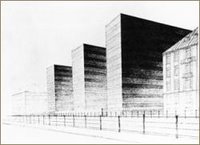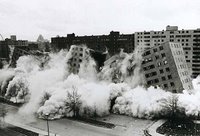 A recent show of modern art at London's V&A has once again put modernism and particularly modern architecture in the spotlight, offering a chance perhaps for a reappraisal of a style whose obituary was deservedly written some years ago, but which is presently enjoying a 'more knowing' revival.
A recent show of modern art at London's V&A has once again put modernism and particularly modern architecture in the spotlight, offering a chance perhaps for a reappraisal of a style whose obituary was deservedly written some years ago, but which is presently enjoying a 'more knowing' revival.Modern architecture died in St. Louis, Missouri on July 15, 1972 at 3:32 pm when the infamous Pruitt-Igoe scheme [left], or rather several of its slab blocks, were given the final coup de grace by dynamite [right].So said architectural critic Charles Jencks, (who unfortunately seized on the awful Pruitt-Igoe and contemporary cultural developments to invent the un-style of post-modernist architecture; Galt save us from po-mo wankers). What Jencks was celebrating in his own way was the much-needed destruction of a thoroughly Modernist, nearly new and utterly inhuman housing project, a project designed whole-heartedly in the 'bourgeouis-proofed' High Modernist tradition of Swiss-French architect-hero Le Corbusier I mentioned this some time ago here).
Who was Le Corbusier? Here's a perfectly fair satire of him by Uncyclopaedia:
Le Corbusier (October 6, 1887–August 27, 1965), a Swiss architect who frequently travelled as a French broom salesman, is single-handedly credited with turning architecture from an art form, one which celebrated man's spirit through the creation of uplifting and inspiring structures, into a vehicle by which humanity housed itself in a bleak, despair-filled world of soulless concrete and glass boxes devoid of anything resembling 2,000 years of human achievement.
 Well put -- many a true word there spoken not entirely in jest. Le Corbusier was merely amongst the most emulated of modernism's elite, amongst whom the aphorism was often as telling as their bland work.
Well put -- many a true word there spoken not entirely in jest. Le Corbusier was merely amongst the most emulated of modernism's elite, amongst whom the aphorism was often as telling as their bland work."Ornament is crime!" declared Adolph Loos -- "less is more," offered Mies van der Rohe (whose Reichsbank design that is at right) -- "Necessity would have to defeat beauty," said the constructivists -- between them helping set off a wave of defiantly un-beautiful 'neutron-bomb' architecture; that is, architecture from which all signs of humanity, beauty or soul were expunged.
 "A house is a machine for living," declared Le Corbusier (whose Casa Weissenhof that is at left). "If the house is a machine for living in," responded the more humane Frank Lloyd Wright, "then the heart is a suction pump." "A building should not be of a style," said Wright, "it should have style." However, like the anti-art of Dadaism from which modernism drew inspiration, heroic modernism rejected all style explicitly, but in the end all it had was this 'non-style' -- a reaction to all the style (and styles) already in existence.
"A house is a machine for living," declared Le Corbusier (whose Casa Weissenhof that is at left). "If the house is a machine for living in," responded the more humane Frank Lloyd Wright, "then the heart is a suction pump." "A building should not be of a style," said Wright, "it should have style." However, like the anti-art of Dadaism from which modernism drew inspiration, heroic modernism rejected all style explicitly, but in the end all it had was this 'non-style' -- a reaction to all the style (and styles) already in existence.Non-style celebrated as style -- what could be more ingenious! And, as it turned out, what could be more dispiriting?
Reviews of the V&A exhibition 'Modernism, Designing A New World 1914-1939' have been mixed, but they do show that the worm is beginning to turn against the sterility of the modernist movement in art, if not yet sure what exactly it's turning to. "To the past," unfortunately appears to be this reviewer's chosen route, an unfortunate conclusion to an otherwise sound review:
It is the most terrifying exhibition I have seen, because it is politics disguised as art. It opens with a word that says it all - utopia - and ends with an unspoken lie, that this nihilist ideology became merely a style and is no longer a threat. If only.
...Only now do I realise that the tawdriness of so much modernist architecture was deliberate. The constructivists sacrificed art as they rejected history, as bourgeois: "Necessity would have to defeat beauty." Harsh manufactured materials such as glass and steel were "appropriate to achieve the communist expression of structure". Hence the bleak minimalism of Mies van der Rohe and the cruel brutalism of Le Corbusier, whose creations must have inspired more human misery than any in history...
The modernist cult took hold most firmly in countries that capitulated easily to dictatorship: Russia, Germany, Italy and France. It was resisted in more resolutely democratic Britain and America. [The exhibition's curator] refers patronisingly to British critics who favoured an art that "gave pleasure, physical and intellectual comfort and a sense of place" as somehow missing the point, if not off the planet... Modernism was never a style. It was a rejection of style, because style required hard work and talent.<
 Rejecting the 'modernist past' does not mean embracing the ancient past as too many cultural commentators would recommend, or moving on to the new non-styles of deconstruction, nihilism and the irrational as too many present-day architectural practitioners have done. Embracing art and architecture that celebrate human life on this earth in this age is possible, as I trust examples of both posted over the last year on this very blog have demonstrated.
Rejecting the 'modernist past' does not mean embracing the ancient past as too many cultural commentators would recommend, or moving on to the new non-styles of deconstruction, nihilism and the irrational as too many present-day architectural practitioners have done. Embracing art and architecture that celebrate human life on this earth in this age is possible, as I trust examples of both posted over the last year on this very blog have demonstrated.LINKS: Pruitt-Igoe & the end of modernity- University of Missouri - St Louis
Le Corbusier - Uncyclopaedia
Brutalism and brutality - Simon Jenkins on the myopic vision of modernity - Guardian
Modernism - Special report - Guardian
TAGS: Art, Architecture, History-Twentieth_Century, Urban_Design

3 comments:
Hi Peter,
I beg to differ in your analysis of Corbusier. His houses pioneered a sensitivity to open, naturally lit spaces. His house sequences often involved moving from a cave-like space upwards toward an open, broadly lit space, as if one were moving towards enlightenment. And the Ronchamp chapel... I have not been there yet but it was extremely influential for Kahn... a composition of concave and convex surfaces responding to the site and creating a complex tension in the structure and the light, as if a mystery hangs in the air... while I am not fond of the sterile white-washed look, I think there is more to Corbusier than you (or that modernist critique) allows.
PS: there are no right angles in the Ronchamp Chapel! hahaha
Brett Holverstott
Brett,
I exclude Ronchamp from my excoriation of Corbusier. That success shows he really did know what he was doing, which might perhaps suggest that his more inhuman creations weren't accidental?
How's your new job? :-)
Hi Peter,
The early phase of Le Corbusier's work, such as the Weissenhofsiedlung in Stuttgart, shown above in your comment, was the result of a massive integration of structure, light and space. By using concrete slabs and pilotis, you free up the walls from their load bearing function, provide vast strip windows and an essentially free plan, with large rooftop terraces open to scenic views. I think this is a huge accomplishment.
But there is also the later phase of work, when Le Corbusier returned to ancient inspirations, creating massive forms that texture the light and exploit the plasticisty of concrete. Of course, concrete was his only option in India, but I think it worked very well, with large sun shields that simultaneously opened the space to prevailing breezes. Ronchamp is merely a stepping stone in this later phase... are you rejecting all other built works by Corbusier, all those in Chandigarh?
I admit that he was a horrible urban planner, which, by the way, were never built. But I believe he was a great architect.
Brett
Post a Comment